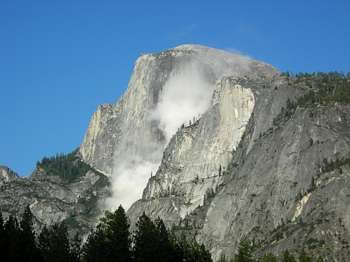Last updated: October 20, 2023
Place
Geology Tour - Rockfall Hazards

Historical/Interpretive Information/Exhibits
As you walked to this stop, you probably noticed the steep, towering cliff and the piles of boulders, called talus, at the base of the cliff. Some of the talus boulders can be quite large. These boulders were once a part of the cliff face and broke loose in events called rockfalls in which boulders fall, bounce and roll down the cliffs and talus piles. The gigantic boulder in front of you now is from a rockfall that occurred about 3,000 years ago. This boulder is one of the largest you will see in Yosemite Valley but boulders like this are actually fairly common. All of them represent past rockfalls. Since glaciers retreated from Yosemite Valley, rockfalls became the dominant geological force eroding the cliffs and they still occur today. Rockfalls happen year-round, with an average of about one event every five days. As of 2020, there have been 16 deaths and more than one hundred injuries related to rockfalls in Yosemite.
Geologists study rockfalls to help the Park Service reduce risk. Research has identified areas in Yosemite Valley at the highest risk from rockfalls. The Park Service use this information to move buildings out of these areas or changed how the buildings are used. These efforts led to a 95% reduction in risk from rockfalls. However, that does not mean people are completely safe. Rockfalls are inherently unpredictable, in part because there are many natural forces that can trigger rockfalls, ranging from rainfall to earthquakes. Rockfalls are a natural force shaping this landscape but they also present a hazard that we need to be aware of as we enjoy this beautiful park.
As you walk along the trail east of the Chapel, take note of the large boulder field on both sides of the trail - what observations can you make about it?
